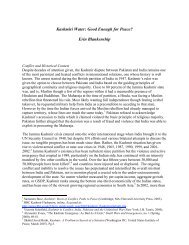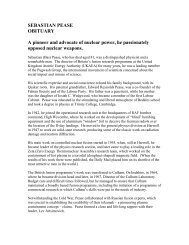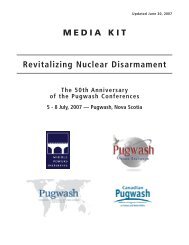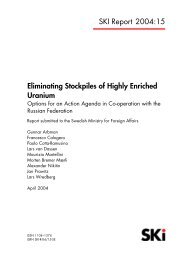The Ninth and Tenth Pugwash Quinquennia 1997–2007
The Ninth and Tenth Pugwash Quinquennia 1997–2007
The Ninth and Tenth Pugwash Quinquennia 1997–2007
Create successful ePaper yourself
Turn your PDF publications into a flip-book with our unique Google optimized e-Paper software.
GOALS OF PUGWASH IN ITS TENTH QUINQUENNIUM, 2002-2007<br />
At the beginning of each quinquennium, the <strong>Pugwash</strong><br />
Council issues a statement relating the enduring mission<br />
<strong>and</strong> objectives of <strong>Pugwash</strong> to its evolving agenda in the<br />
context of recent international developments. <strong>The</strong><br />
following contains the goals of <strong>Pugwash</strong> for its <strong>Tenth</strong><br />
Quinquennium, from 2002 to 2007, adopted at a plenary<br />
session of the 52nd <strong>Pugwash</strong> Conference at the University<br />
of California, San Diego, in August 2002.<br />
************************<br />
<strong>The</strong> overriding peril which preoccupied the founders<br />
of <strong>Pugwash</strong> in 1955-1957, <strong>and</strong> which has claimed<br />
much of the attention of <strong>Pugwash</strong> participants in<br />
the intervening 45 years, is the danger posed to humanity<br />
by the vast destructive power of nuclear weapons, the<br />
accumulation of these weapons in huge numbers in the<br />
arsenals of the United States <strong>and</strong> Russia, <strong>and</strong> their spread<br />
into the possession of the United Kingdom, France, China,<br />
India, Pakistan <strong>and</strong> Israel. To these ongoing challenges<br />
must now be added the increased threats posed by the<br />
possible acquisition <strong>and</strong> use of weapons of mass destruction<br />
by other states <strong>and</strong> by non-state groups.<br />
<strong>Pugwash</strong> is strongly committed to the goal of abolishing<br />
all nuclear weapons. It is imperative that <strong>Pugwash</strong><br />
constantly remind the international community of the<br />
immorality, illegality, <strong>and</strong> peril inherent in nuclear<br />
weapons, <strong>and</strong> to propose concrete steps towards their<br />
elimination.<br />
Despite promising steps in the early 1990s to reduce<br />
the numbers of nuclear weapons, more recent developments<br />
give rise to serious concern about a reversal in this<br />
process of controlling, reducing <strong>and</strong> abolishing nuclear<br />
weapons. <strong>The</strong> nuclear peril, while somewhat abated,<br />
nonetheless persists:<br />
• in the tens of thous<strong>and</strong>s of weapons still deployed (many<br />
in rapid response alert),<br />
• in doctrines calling for the first use of nuclear weapons,<br />
<strong>and</strong> also for the possible use of nuclear weapons against<br />
non-nuclear countries,<br />
• in the presence of nuclear weapons in regions having a<br />
significant risk of conflict<br />
4 <strong>Pugwash</strong> Newsletter SPECIAL EDITION, October 2007<br />
• in the risk of the further spread of nuclear weapons,<br />
• in the risk of theft of nuclear weapons or nuclearweapons<br />
material from widely dispersed <strong>and</strong> sometimes<br />
inadequately guarded stockpiles,<br />
• in the risk of the use of nuclear weapons by international<br />
terrorist groups,<br />
• in the development of new types of nuclear weapons,<br />
that may call for the resumption of nuclear tests,<br />
• in the challenge to arms control <strong>and</strong> strategic stability<br />
posed by the development of missile defenses <strong>and</strong> the<br />
deployment of new types of weapons.<br />
<strong>The</strong> whole system of nuclear arms control is, moreover,<br />
under strain, with treaties that are renounced by one<br />
party (the ABM Treaty), treaties that are not ratified<br />
(Comprehensive Test Ban Treaty), proposed treaties where<br />
no apparent progress is made (Fissile Material Cutoff<br />
Treaty), <strong>and</strong> commitments for nuclear arms control <strong>and</strong><br />
disarmament, such as the 13 steps of the 2000 NPT<br />
Review Conference, that are assumed but largely disregarded<br />
in practice. Most importantly, the implementation<br />
of Article VI of the NPT that m<strong>and</strong>ates nuclear disarmament<br />
is far from being the basis of the policy of the nuclear<br />
powers.<br />
Thus the <strong>Pugwash</strong> goal of reducing <strong>and</strong> eliminating the<br />
nuclear peril will be more important than ever in the <strong>Tenth</strong><br />
Quinquennium. Specific points on the <strong>Pugwash</strong> agenda<br />
will include prescriptions for much deeper cuts in nuclear<br />
arsenals, for the effective dismantlement of retired<br />
warheads, for much greater transparency <strong>and</strong> control of<br />
all the deployed forces <strong>and</strong> warheads in storage, for<br />
stronger non-proliferation measures <strong>and</strong> verification, especially<br />
regarding the safety of nuclear materials, for fast<br />
disposal of fissile material, for the entry into force of the<br />
nuclear test ban, for a stop to the production of new<br />
weapons <strong>and</strong> new weapon-grade material, <strong>and</strong> for the<br />
ab<strong>and</strong>onment of nuclear policies that allow an early use or<br />
a first use of nuclear weapons. <strong>Pugwash</strong> will also consider<br />
as an essential element of the non-proliferation agenda the<br />
prevention of the proliferation of expertise, where nuclear<br />
weapons experts may be induced to work for countries or<br />
subnational groups wishing to acquire nuclear weapons







